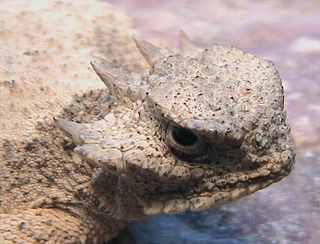Behavior
It often basks in the sun in the morning and evening. When threatened, the lizard can shoot blood out of the corners of its eyes. However, this is mainly used in desperate emergencies, else it will try to run to the nearest bush it can find, dive in a rodent's burrow, or bury/shuffle into the sand like a shovel. If it is grabbed, it will swell, hiss, stab with its horns, and try to bite. If further provocation occurs, the blood-squirting starts.

Horned lizards (Phrynosoma), also known as horny toads or horntoads, are a genus of North American lizards and the type genus of the family Phrynosomatidae. The common names refer directly to their horns or to their flattened, rounded bodies, and blunt snouts.

The greater short-horned lizard, also commonly known as the mountain short-horned lizard, is a species of lizard endemic to western North America. Like other horned lizards, it is often called a "horned toad" or "horny toad", but it is not a toad at all. It is a reptile, not an amphibian. It is one of seven native species of lizards in Canada.

Cerastes cerastes, commonly known as the Saharan horned viper or the desert horned viper, is a venomous species of viper native to the deserts of northern Africa and parts of the Arabian Peninsula and Levant. It often is easily recognized by the presence of a pair of supraocular "horns", although hornless individuals do occur. Three subspecies have been described.

The Texas horned lizard is one of about 14 North American species of spikey-bodied reptiles called horned lizards, all belonging the genus Phrynosoma. P. cornutum ranges from Colorado and Kansas to northern Mexico, and from southeastern Arizona to Texas. Also, isolated introduced populations are found in the Carolinas, Georgia, and Florida. Most records of the Texas horned lizard from the Piney Woods region of east Texas, Louisiana, and Arkansas are from the early and mid-twentieth century, a time when horned lizard were popular pets, and are thought to represent released or escaped pets and not the species natural range. Though some populations are stable, severe population declines have occurred in many areas of Texas and Oklahoma. The Texas spiny lizard may be confused for a Texas horned lizard due to its appearance and overlapping habitat.

The desert horned lizard is a species of phrynosomatid lizard native to western North America. They are often referred to as "horny toads", although they are not toads, but lizards.

The Namaqua chameleon is a ground-living lizard found in the western desert regions of Namibia, South Africa and southern Angola.

The roundtail horned lizard is one of the smaller species of horned lizard. Their specific epithet is from the Latin word modestum, meaning modest or calm. They are found in the United States, in western Texas, New Mexico eastern Arizona, southeastern Colorado and eight states in northcentral Mexico where they are referred to as "tapayaxtin".

Cerastes is a genus of small, venomous vipers found in the deserts and semi-deserts of northern North Africa eastward through Arabia and Iran. Three species are currently recognized by "ITIS", and an additional recently described species is recognized by the Reptile Database. Common names for members the genus include horned vipers, North African desert vipers, and cerastes vipers.

Heterodon platirhinos, commonly known as the eastern hog-nosed snake, spreading adder, or deaf adder, is a colubrid species endemic to North America. No subspecies are currently recognized.

Vipera ammodytes is a viper species found in southern Europe, mainly the Balkans, and parts of the Middle East. It is reputed to be the most dangerous of the European vipers due to its large size, long fangs and high venom toxicity. The specific name, ammodytes, is derived from the Greek words ammos, meaning "sand", and dutes, meaning "burrower" or "diver", despite its preference for rocky habitats. Five subspecies are currently recognized, including the nominate subspecies described here.

Walterinnesia is a genus of venomous snakes in the family Elapidae. The genus contains two species, known commonly as desert black snakes or black desert cobras, which are endemic to the Middle East. The generic name Walterinnesia honours Walter Francis Innes Bey (1858–1937), who was a physician and zoologist in Egypt.

Trioceros melleri, with the common names Meller's chameleon and giant one-horned chameleon, is the largest species of chameleon from the African mainland.

The regal horned lizard is a horned lizard species native to Mexico and the Southwest United States.
Skrjabinoptera phrynosoma is a parasitic worm in the phylum Nematoda, the most diverse of pseudocoelomates. Like many other parasites, the life cycle of S. phrynosoma is complicated and it involves two hosts – a lizard and an ant.
Wyoming is home to 12 amphibian species and 22 species of reptiles.

The pygmy short-horned lizard is a species of small horned lizard that occurs in the northwestern United States as well as in the southwestern Canada. Like other horned lizards, it is often called a "horned toad" or "horny toad," but it is not a toad at all. It is a reptile, not an amphibian.

The central netted dragon or central netted ground dragon, Ctenophorus nuchalis, is a species of agamid lizard occurring in a wide range of arid to semiarid regions of Australia. It is widespread across the continent, commonly found in open, sandy, desert habitats. It is a popular pet and can often be found in zoos.














